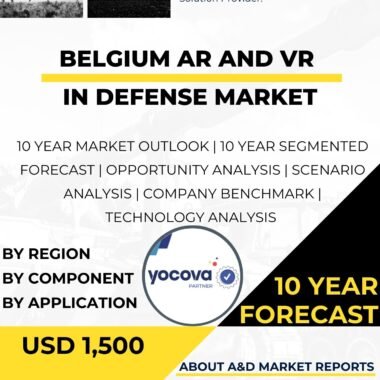Description
Japan AR & VR in Defense Market has grown rapidly in recent years. This growth is driven by the nation’s focus on strengthening its defense capabilities through advanced technologies. AR and VR provide innovative solutions across training, situational awareness, mission planning, and maintenance, transforming how Japan prepares and operates its defense forces.
AR overlays computer-generated information onto the real world, while VR immerses users in a fully virtual environment. Both technologies enable realistic, interactive experiences that improve training outcomes, decision-making, and operational effectiveness.
Training and Simulation
One of the main applications of AR and VR is military training. These platforms provide cost-effective, risk-free environments for personnel to practice complex maneuvers and simulate combat scenarios. Trainees develop critical decision-making skills and situational awareness. AR and VR simulators are also used for specific platforms, including aircraft, ground vehicles, and naval vessels. Pilots, drivers, and crew can practice in environments closely replicating real operations, enhancing readiness and skill levels.
Situational Awareness and Decision-Making
AR-enabled devices, such as smart glasses or heads-up displays (HUDs), provide real-time information directly in the field of view. Terrain data, enemy positions, and friendly unit locations can be visualized instantly, allowing personnel to make informed, timely decisions. This augmented situational awareness improves mission effectiveness and safety in dynamic operational environments.
Mission Planning and Maintenance
VR-based mission rehearsal tools help planners simulate and evaluate complex operations before execution. This capability enhances coordination, risk assessment, and operational success. AR is also applied to maintenance, guiding technicians through complex repairs with visual overlays and step-by-step instructions. These systems reduce downtime, improve efficiency, and ensure equipment readiness.
Domestic and International Development
Japan’s defense industry actively develops AR and VR solutions tailored to national requirements. Collaboration between government agencies and domestic defense companies drives innovation and strengthens the domestic market. International partnerships with allied nations also provide access to cutting-edge AR and VR technologies, fostering knowledge sharing and technological advancement.
Challenges
The AR and VR market in defense faces several challenges. Cybersecurity is critical, as these systems increasingly handle sensitive operational and training data. Ensuring system compatibility and standardization across platforms is also vital for interoperability among different branches of the Self-Defense Forces. Cost considerations may limit widespread adoption, as advanced AR and VR technologies require significant investment.
Conclusion
The AR and VR market in Japan’s defense sector is strategically important and continues to grow. These technologies enhance training, situational awareness, mission planning, and maintenance operations. Collaboration between the government, domestic industry, and international partners drives innovation and strengthens the market. Addressing cybersecurity, interoperability, and cost challenges will further improve Japan’s ability to leverage AR and VR for effective, modern defense operations. With its strategic focus on technological innovation, Japan remains committed to using AR and VR solutions to enhance defense readiness, operational effectiveness, and regional security.




